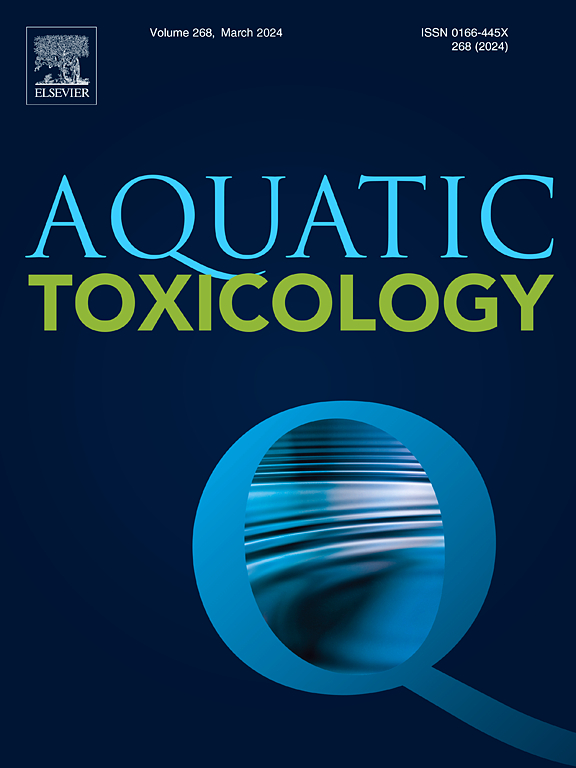Individual and combined toxicity of personal care products and pharmaceuticals at environmentally relevant concentrations due to chronic exposure of the freshwater microcrustacean Daphnia magna
IF 4.1
2区 环境科学与生态学
Q1 MARINE & FRESHWATER BIOLOGY
引用次数: 0
Abstract
Personal care products and pharmaceuticals, namely sodium diclofenac (DCF), octocrylene (OCT), and sodium dodecyl sulfate (SDS), are relevant chemical products classified as contaminants of emerging concern (CECs). They can enter aquatic ecosystems from various anthropogenic sources. This study examined the acute and chronic toxic effects of exposure to these substances, individually and in binary mixtures (OCT + SDS, SDS + DCF, DCF + SDS). Chronic effects were evaluated at environmentally relevant concentrations. To evaluate the mixtures, the Abbott method was used to predict acute toxicity using the inhibition ratio value, while for chronic effects, the concentration addition (CA) and independent action (IA) models were used for predictive assessment. According to EC5048h values, the toxicity levels to D. magna were OCT > SDS > DCF. When exposed to binary mixtures, these compounds predominantly exhibited antagonistic interaction for acute effects. Regarding chronic effects, there were no observed effects at the environmentally relevant concentrations tested for individual and mixed exposure compared to the control. The locomotion parameter exhibited a difference in dispersion with increasing chemical concentration. These results can improve understanding of the damage produced by exposure to mixtures of different CECs.
由于长期接触淡水微甲壳类动物大水蚤,个人护理产品和药物在环境相关浓度下的个体和联合毒性
个人护理产品和药品,即双氯芬酸钠(DCF)、八烯丙烯(OCT)和十二烷基硫酸钠(SDS),是被归类为新兴关注污染物(CECs)的相关化学产品。它们可以从各种人为来源进入水生生态系统。本研究考察了暴露于这些物质的急性和慢性毒性作用,包括单独和二元混合物(OCT + SDS, SDS + DCF, DCF + SDS)。在与环境相关的浓度下评估慢性效应。为了评估混合物,采用雅培方法预测急性毒性,使用抑制比值,而对于慢性效应,使用浓度添加(CA)和独立作用(IA)模型进行预测评估。根据EC5048h值,对D. magna的毒性等级为OCT >;SDS祝辞贴现。当暴露于二元混合物时,这些化合物主要表现出拮抗相互作用的急性效应。关于慢性影响,与对照组相比,在个人和混合暴露的环境相关浓度下,没有观察到任何影响。随着化学物质浓度的增加,运动参数的分散性有所不同。这些结果可以提高对暴露于不同CECs混合物所产生的损伤的理解。
本文章由计算机程序翻译,如有差异,请以英文原文为准。
求助全文
约1分钟内获得全文
求助全文
来源期刊

Aquatic Toxicology
环境科学-毒理学
CiteScore
7.10
自引率
4.40%
发文量
250
审稿时长
56 days
期刊介绍:
Aquatic Toxicology publishes significant contributions that increase the understanding of the impact of harmful substances (including natural and synthetic chemicals) on aquatic organisms and ecosystems.
Aquatic Toxicology considers both laboratory and field studies with a focus on marine/ freshwater environments. We strive to attract high quality original scientific papers, critical reviews and expert opinion papers in the following areas: Effects of harmful substances on molecular, cellular, sub-organismal, organismal, population, community, and ecosystem level; Toxic Mechanisms; Genetic disturbances, transgenerational effects, behavioral and adaptive responses; Impacts of harmful substances on structure, function of and services provided by aquatic ecosystems; Mixture toxicity assessment; Statistical approaches to predict exposure to and hazards of contaminants
The journal also considers manuscripts in other areas, such as the development of innovative concepts, approaches, and methodologies, which promote the wider application of toxicological datasets to the protection of aquatic environments and inform ecological risk assessments and decision making by relevant authorities.
 求助内容:
求助内容: 应助结果提醒方式:
应助结果提醒方式:


